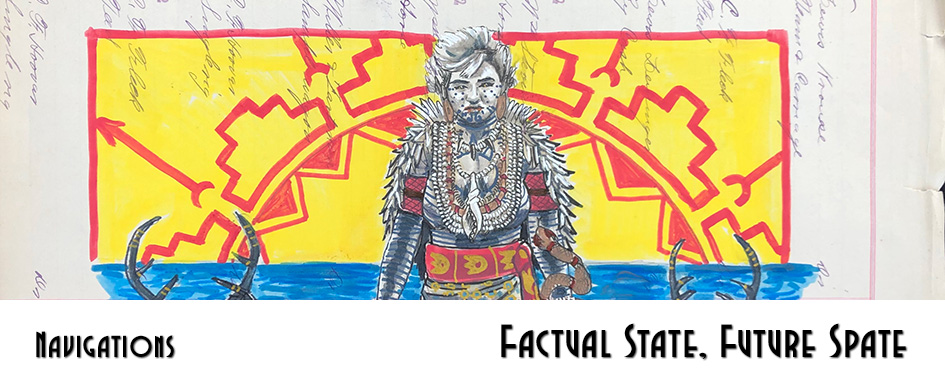Deep the fish mill and fin, hidden in the cold, anonymous comfort of the big waters of Lake Erie. But they can’t help it. They won’t stay. The fish spend their lives doing whatever it is their instincts tell them to do—to gulp down their food, to hide from danger, to home in on the safest spot to drop their eggs, at least this is what we surmise. If they are telling their own stories, we do not hear them, or maybe we are simply not listening, but either way, we tell ourselves our own stories about them. Gradually they make their way into the shallows of the lake. They are sensitive beings, aware of small changes in temperature, the slightest current—tuned to the shifts of the world. They are not, however, tuned to the shifts of the people in the world, and while these fish do not live in the world of people, they cannot help but be affected by them. They have a long history, and a short history, of meeting threats, both macro and micro, to their survival. Many of the fish are sick or injured. They are not unlike people in this regard.
Some of these Erie fish head up the Niagara River, others remain in the great lake, and still a few others nose into a lesser-known river called Barren Creek, at least that is what it is called now. Its original name they felt was unpronounceable and the translation too unwieldy. What the original peoples called it was a concept that doesn’t fit into one English word, the name meant a water force so swiftly moving, so bubbly, so energetic, so full of life and sustenance that it is infinite and precious, yet it is also simultaneously vulnerable and fierce in ways that mean we humans must protect it and also fear it but, of course, in a deeply respectful way. Instead, the newcomers called it the opposite. Barren, as in bleak and lifeless and empty and unfruitful. This small river now called Barren Creek flows into Lake Erie at the harbor, where there are now barges and tugboats and a ramshackle port that long ago, in conjunction with its once bustling railroad lines, gave the city its former claim to fame as a powerful industrial center. Around the mouth of Barren Creek, there are landfills where there were once marshes and small bays, the kind of which used to provide perfect spawning and nursery grounds as well as the homes for waterfowl, marsh birds, and muskrats, and atop these sometimes hazardous landfills, there are warehouses and gigantic cement buildings that used to house, among other things, lumber and paper mills, steel mills, and industrial plants of all kinds, from those that make synthetic materials for clothing and household items to those that produce airplane parts. This wasteland of mostly empty warehouses and not so empty bars now suffers from a city government attempt at revitalization. They are converting some warehouses into businesses, like the self-storage building on First Avenue and the complex of artist studios, loft apartments and restaurants, including one very popular sushi bar.
The fish continue up Barren Creek through downtown’s square mile of skyscrapers and high-rises, most of them connected by skyways for the harsh winters, and quickly swim past the suburbs. They pass the football stadium that brings snarling traffic over the bridges and through the roads to the international airport, the strip malls, and rows of nearly identical houses and yards. Once the fish pass the suburbs, their migration takes them into the rolling hills and forests of the countryside with its corn, cabbage, alfalfa fields, and the brick farmhouses and red barns that flank them.
Here the country roads are quieter than the city and the suburbs, there is more soil than concrete which means you can breathe easier, if you are not a fish, and if you don’t allow yourself to think about how much blood and viscera has been absorbed by the soil over hundreds of years before and mostly after the newcomers arrived. Here, the bridges the creek flows under are likely to see more fishermen than cars in a day. Here, the fish will pass through a fragrant landscape of orchards—cherry and apple, peach and plum—and a less fragrant one of farms raising everything from pigs and cows to potatoes and corn. They will even pass a few vineyards and stables that specialize in raising Arabian racehorses. These horses can run at the nearby racetrack, the one that used to get all the local gambling business before the Seneca built their casino, the one at the center of a very explosive tax dispute.
Soon the fish will pass through a place called Troytown, a town some might call quaint. The creek burbles through a pleasant picnicking park filled with pavilions and charcoal grills and playgrounds and verdant fields of grass. Here the soil is fertile. Here the water from the creek was once used to power the gristmills and sawmills that helped spawn the town in the early nineteenth century. Water from the creek once was also used to fill the salt mines, another industry that helped give the town its original fortunes. The main streets used to be lined with grand old houses, many of which have fallen into disrepair, especially since the Indian land claims began, and one of which—a most unusual and beautiful octagon-shaped Victorian house, the only one of its kind in the whole Northeast—will soon be only a pile of ash and debris. As the fish pass out of town, they will swim by the canning factory that is still supplied by the farms nearby and whose migrant workers mostly live in the labor camps along the flint ridge that rises over the southern edge of town.
Several miles later, they will swim through the Barren Creek Indian reservation. From the perspective of the fish, it doesn’t look much different from the countryside, except that the banks are lined with thicker, longer stretches of forests from which the deer emerge less cautiously to drink from the creek than they do in the countryside. If the fish were people, they would drive onto the reservation and pass the sign welcoming them to the Barren Creek Band of Seneca, the sign that is now full of bullet holes and spray-painted warnings. They would pass through a space between concrete barriers pulled across most of the road and might be questioned by the men and women with rifles or waved on through the checkpoint if the warrior people knew them. They would smell the acrid odor of burning tires and civil chaos and see the defaced billboard that used to invite visitors to win big money at the Barren Creek Casino and the many signs pointing the way to shops full of cheap gas and cigarettes. They would also see children riding bikes along the roads and teens playing in the lacrosse fields and women congregating at the longhouse for a clan meeting and local farmers selling brightly colored produce at roadside stands.
But the fish don’t see these things from the river.
Instead, they see the woods bordering the creek—groves of maples and oaks, stands of pine and dense brush. And they see some plots of land that are farmed. And they see the clearings where there are all kinds of houses—from double-wide trailers to clapboard houses to log cabins—and yards dotted with swing-sets or trampolines or rusting cars or tractors. Some of the families who live in these houses have lived here for generations and generations and generations—they are rooted here where their ancestors lived for thousands of years, ever since Skywoman fell and was gently caught by waterfowl who teamed up with the other creatures of the watery world to make her a home on the turtle’s back thanks to the magic of a women’s shuffle dance and soil from the depths of the ocean. These families have been here on these plots of land a mere fraction of their expansive traditional territories, they’ve been here since the tribe “purchased” the land back from the land company who’d stolen it from them in the early nineteenth century. In the houses the fish pass on the reservation live an elderly woman who is convinced by a ghost to kill because sometimes forgetting is unmerciful, and a couple whose little boy was killed by the police, and an old woman with the power to smell death. In one lives a man whose power to disrupt electrical impulses has meant a difficult, destructive life until he realizes some things are meant to be taken apart and in another lives a man who soon will have to leave because sometimes even the people you love can be corrupt.
Some fish, usually the more adventurous steelheads and brown trout, will make their way down a tributary that feeds into a reservoir many miles south that is now a state park for camping, hiking, and fishing. This park sits on what was once part of the tribe’s greater homeland before the government flooded their valley and dammed it up. The Seneca fought against losing their homes, their land, their burial grounds, fought for the Americans not to break their treaty with the Seneca—treaties, after all, are the supreme law of the land according to the Constitution—but alas, that fight was lost. That loss for the Seneca, along with so many others, was handed down the generations, a bloody, pus-filled wound that was only partially scabbed over and is now lightly soothed with the aromatic balm of the recent win of a tribal land claims case. But even with that, the win for the tribe brings discord and fear and danger, both on and off the reservation.
But the fish do not see these things.
Near the heart of the reservation where the river gets shallow and gravelly, some of these fish, the mothers, will lay their eggs—their future children whom they will never know or nurture but for whom their instinctual selves hold faith in survival—in hollows that they’ve prepared by scraping their tails against the creek-bed. They leave the eggs to be fertilized by the passing fathers. Some will return to the lake, others will continue on to die, easily, quietly.


